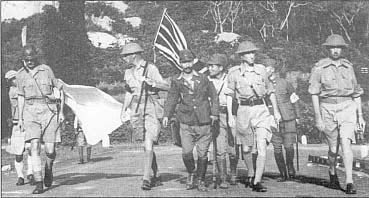![]() The Pacific War Online Encyclopedia
The Pacific War Online Encyclopedia
|
| Previous: Sims Class, U.S. Destroyers | Table of Contents | Next: Singkawang |

Singapore (103.868E
1.296N) was Britain's
Gibraltar of the Far East, completed at great expense just in time
for the Pacific War. Its architects assumed that a land attack down the Malaya Peninsula was militarily
impossible, and its defenses were oriented against a sea attack.
Singapore defenses included, on the north tip of the island: 3
batteries of 2 6” naval rifles, 1 battery of
3 9.2” naval rifles, and 1 battery of 3 15” naval rifles; on the
south tip near the city, 4 batteries of 2 6” naval rifles and 1
battery of 3 9.2” naval rifles; and on the west tip, 1 battery of
2 6” naval rifles. All were sited in steel casemates. The
huge dry dock at Changi Naval Base
was large enough for any warship in the
British Fleet, and the island was dotted with four airfields. The cost of
all this work was 60 million pounds, equal to about three billion
1997 dollars. The main civilian port, Keppel Harbour, was located
on the southern coast, and the main fuel
depot was on Bukum Island (103.750E
1.232N).
The island became a British colony at the
instigation of Sir Thomas Raffles, who feared growing Dutch
influence in the area. In 1819, Raffles resolved a dispute over
the Sultanship of Johore in return for a treaty from the new
Sultan giving the British the right to establish a trading post in
return for a lease of $8,000 a year.
Singapore was strategically located for a major
naval base, but in other respects it was an unfortunate
choice. It is nestled against the mainland and surrounded by
islands, and it had little industrial infrastructure in
1941. A bad situation was made worse by poor planning:
The naval base was situated in the Johore Straits, just across
from the mainland. The coastal batteries, although capable
of firing on the mainland, were supplied primarily with armor-piercing shells, which were
almost useless in land warfare due to their tendency to penetrate
deep into the ground before detonating. The population of 550,000
had nearly doubled from an influx of refugees, taxing the limited
fresh water supplies.
The bottom line was that Singapore was indefensible
without control of the air and seas around it. Control of
the air was denied by the swift capture of northern Malayan
airfields by the Japanese and
the superior quality of Japanese air forces, but more so by the
decision of Churchill to
divert 200 Hurricane
fighters to Russia to prevent
a collapse. Control of the seas was denied when Force Z, the Prince of Wales
and Repulse,
were sunk in the first few days of the war. With their loss, and
with no prospects of naval reinforcements, Singapore ceased to be
of any value as a naval base and fortress, but it was politically
impossible for the British to abandon the base. Instead, 17
Indian Division and 18 Division
were sent as reinforcements, but without time to acclimatize and
be integrated into the defense, this "was tantamount to marching
[the] soldiers straight off their ships into Japanese prisoner-of-war camps"
(Willmott 1982).
All British forces in Malaya had been withdrawn to
Singapore by 4 February 1942, when the first surrender demand from the
Japanese was rejected. On the night of 8 February, elements
of the 5,
18,
and Imperial Guards Divisions
successfully crossed the Johore Straits and established beachheads
against the Australian
22
Brigade. The city was surrendered on 15 February 1942,
after the capture of the reservoirs by the Japanese cut off the
water supply.
A number of atrocities
occurred during the campaign. On 13 February 1942, the Imperial Guards bayoneted
over 300 doctors and
patients at Alexandria Barracks Hospital. Following the surrender,
the Kempeitai perpetrated the Sook Ching
("purification of the area") in which between 6000 and 50,000
Malay Chinese were massacred. The survivors
were ordered to pay $50 million as what amounted to "a ransom for
their lives" (Collingham 2011). Hicks (1994) has suggested that
the accompanying demand that the Chinese community provide
"comfort" to the Japanese occupation forces was a demand for comfort women.
Following its surrender, the Japanese renamed
Singapore Shōnantō. The city remained in Japanese hands
until the final surrender.
It was periodically raided by B-29s from 5
November 1944 on. A British plan to recapture Singapore, Operation
MAILFIST, could not be carried out before the Japanese surrender.
Climate Information
Elevation 33'
Temperatures: Jan 86/73, Apr 88/75, Jul 88/75, Oct 87/74, record 97/66
Rainfall: Jan 17/9.9, Apr 15/7.4, Jul 13/6.7, Oct 16/8.2 == 95.0" per annum
References
Hicks (1994)Thompson
(2005)
Willmott (1982)
The Pacific War Online Encyclopedia © 2006-2007, 2009, 2011-2013, 2015 by Kent G. Budge. Index